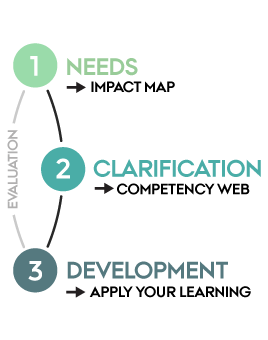Tools for strategic and systematic competency development
Coupling the development of management and employee competencies to AU's strategy is no easy task. Your unit can approach it together in three phases:
What learning activities should we initiate?
How do we ensure the proper transfer of what is learned?
1) The Impact Map tool
Use the impact map tool to help break down the overall strategic goals for AU into specific goals for your unit and your employees.
The tool is a relevant part of group/team development dialogues at your department/unit.
Watch the video for a specific, step-by-step presentation of the tool (English subtitles).
It is a relatively simple and practicable model for defining the framework and the direction for your department/unit. Use the tool to help bridge the gap between your unit’s tasks and strategic goals – and the competencies required to meet them.
In other words, the impact map helps you to focus on developing the competencies that are most critical for the unit and its employees to be able to perform the tasks required of them, also in the future.
The tool was developed by Professor Robert Brinkerhoff.
2) The Competency Web tool
Having identified the strategic competency needs in the impact map, the next step is to clarify where to focus your efforts as a team.
A competency web is simply a pentagon-shaped “shooting target” with two lines. In each of the pentagon’s five corners, write the competencies you identified together during your group/team development dialogues as competencies that you need to strengthen so that you can continue your tasks in the future.
- One line illustrates the degree of need for competencies: the further out towards the rim of the target, the greater the competency need.
- The other line shows where we assess our competency level to be today.
Use the diagram as the basis for dialogue on development plans and priorities.
3) The Apply Your Learning tool
Use this tool to evaluate - through dialogue - whether the learning activities you initiate are creating the learning required. And whether this is leading to new results.
About learning activities
Competency development – and learning – is more than just courses and training programmes. New knowledge, skills or approaches can be developed in many ways.
Competency development initiatives have often been synonymous with external courses or further education programmes. In AU’s staff policy, however, competency development is described and recognised as much more than that. Competency development covers all activities that challenge and expand the individual employee’s knowledge, qualifications and skills in relation to present and future challenges.
This means that when planning competency development initiatives, you should always consider what would be the best and most resource-efficient way to reach the desired objective. You should therefore first ask ”What do we need to learn?” and then ”How do we best go about learning this?”.
INTERNAL, PLANNED
- Internal networks
- Peer-to-peer training
- Coaching
- Feedback
- Group development dialogues
- Mentorship programmes
- Learning from new employees
- Job swaps, visits, exchange
- New tasks
- Project/team organisation
- Specialisation
- Reflection
- Training
- Knowledge sharing
- Better meetings through evaluation
INTERNAL, INFORMAL
- Informal knowledge sharing
- Ongoing and informal collegial discussion regarding:
- the learning culture (urge to develop, competition, openness, etc.)
- the workplace culture
- followership
- collegiality
- good management
- self-management
- quality in task performance
- etc.
From learning activity to new practice
A typical challenge in learning and competency development is how to ensure there is no mismatch between new learning and the situation in which this new learning will be applied. This is also known as the transfer problem or implementation problem.
One way to achieve effective competency development is to focus on the transfer aspect: practising and applying what you've learned (e.g. in the performance of new tasks, by sharing knowledge and methods with colleagues, etc.), and by talking about the value this creates for the department/unit. For this you can use the "Dialogue tool: Learning.”

